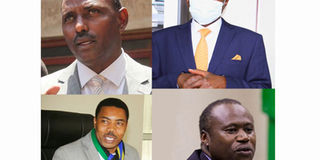EAC govts read from same script on Budget

Top L-R: Kenyan Finance minister Ukur Yatani Kanacho, State minister for Finance (Planning) Amos Lugoloobi
Bottom L-R: Tanzanian Finance minister Mwigulu, Nchemba, Rwandan Finance minister Uzziel Ndagijimana
What you need to know:
In order to deal with the growing debt burden, East African countries are raising taxes and borrowing further
The East African Community (EAC) countries entered the Covid-19 pandemic borrowing from the future.
Kenya is the most extreme case in point and its public debt-service costs will surge to a record Ksh1.17 trillion, consuming about two-thirds of domestic revenue.
Uganda debt could approach 50 per cent of Gross Domestic Product (GDP) at the end of June. This, according to Moody’s Investors Service, is up from 40 per cent of GDP in 2020, and 22 per cent recorded in 2013.
Yet, in the region, Tanzania has been the most fiscally conservative.
Mr Alykhan Satchu, a renowned EAC regional economic expert, sharing his thoughts on regional governments’ resource envelopes said: “Covid-19 was a circuit breaker and now countries are not cutting back on expenditure but raising taxes and borrowing further. I am not convinced that citizens can bear higher taxes at a time when our economies are still weak.”
Satchu, who is also the chief executive officer of Rich Management SSA Advisory, further advises: “I would prefer EAC governments to take surgical action around their ever increasing expenditure which in my view is supersized for our economies especially now after the pandemic.”
In Uganda, the resource envelope for the financial year 2021/2022 has been revised downwards to Shs44.7 trillion from Shs45.5 trillion in the ending financial year indicating a 1.7 per cent drop.
Human capital development now takes the lion’s share with Shs7.6 trillion followed by governance and security with Shs6.97 trillion.
Governance and security had the lion’s share in the initial Budget but it has been slashed by Shs750b.
The integrated transport infrastructure and services comes in third position with Shs5 trillion, up from Shs3.9 trillion. Similarly, Kenya plans to spend in excess of Ksh3.6 trillion in 2021/2022 budget. This is a deficit of more than Ksh1 trillion, which the regional member governments expect to borrow domestically.
The budget hopes to strike a balance between stimulating economic recovery and responding to the health challenges of the Covid-19 pandemic.
“In preparing the estimates, we have been alive to the current challenges of the ongoing pandemic, while ensuring that we continue on a steady path of economic recovery by investing KShs26.6 billion on the post Covid-19 Economic Stimulus Programme (PC-ESP),” Mr Ukur Yatani, Kenya’s Cabinet Secretary, said.
Kenya also intends to spend KShs135.3b on the President’s Big Four Agenda covering universal healthcare, food and nutrition, manufacturing, and affordable housing.
“We are proposing to introduce VAT [Value Added Tax] exemptions on ventilators, decongestants and supplements to boost the health sector by lowering costs, while supporting youth employment by proposing tax deductions for employers that engage Technical and Vocational Education and Training (TVET) graduates as apprentices,” Mr Yatani shared.
Kenya is also proposing several amendments to enhance tax administration and dispute resolution operations.
“These proposals alongside others contained in the Finance Bill will create the legal and policy framework to achieve our medium-term budget goals,” Mr Yatani asserted.
In Tanzania, according to the 2021/2022 budget framework and National Development Plan, the government plans to collect and spend a total of $15.6 billion during the coming financial year.
At least $8b will be foreign sourced money to fund the budget while 60.9 per cent will be sourced locally.
Tanzania’s new President Samia Suluhu Hassan intends to grow the economy with the private sector in the lead. Major priority areas will be agriculture and manufacturing to improve the poverty levels in Tanzania.
Rwanda’s outlook is for a gradual recovery in economic activity from the drop of 3.4 per cent in 2020.
The economy is projected to grow by 5.1 per cent in 2021, 7 per cent in 2022 and on average by 7.8 per cent in 2023 and 2024.
Minister of State in Charge of National Treasury Richard Tusabe earlier said Rwanda’s growth projection reflects the actions already in place or that will be put in place by government to mitigate the economic impact of Covid-19.
Rwanda’s budget for the fiscal year 2021/2022 will reflect medium term fiscal path which allows for an increased spending to reach National Strategy Transformation (NST1) goals while maintaining public debt at sustainable levels.
Rwanda’s total budget for the fiscal year 2021/2022 is Frw3.806 trillion, made up of domestic resources amounting to Frw2.543 trillion (comprising of Frw1.717 trillion from tax revenue) and Frw1.263 trillion from external resources.
On expenditure, key priorities will include; access to quality health, increasing agriculture and livestock productivity, scaling up social protection coverage, improving the quality of education, and supporting businesses (through the economic recovery fund and the manufacturing, build to recover program) to invest for recovery.
EAC
2021/2022 Budgets
•Uganda: Shs44.7 trillion from Shs45.5 trillion in 2020/2021
•Kenya: Ksh3.6 trillion from Kshs2.7 trillion in 2020/2021
•Tanzania: $15.6 billion
•Rwanda – Frw3.8 trillion from Rwf3.2tn 2021/2020




